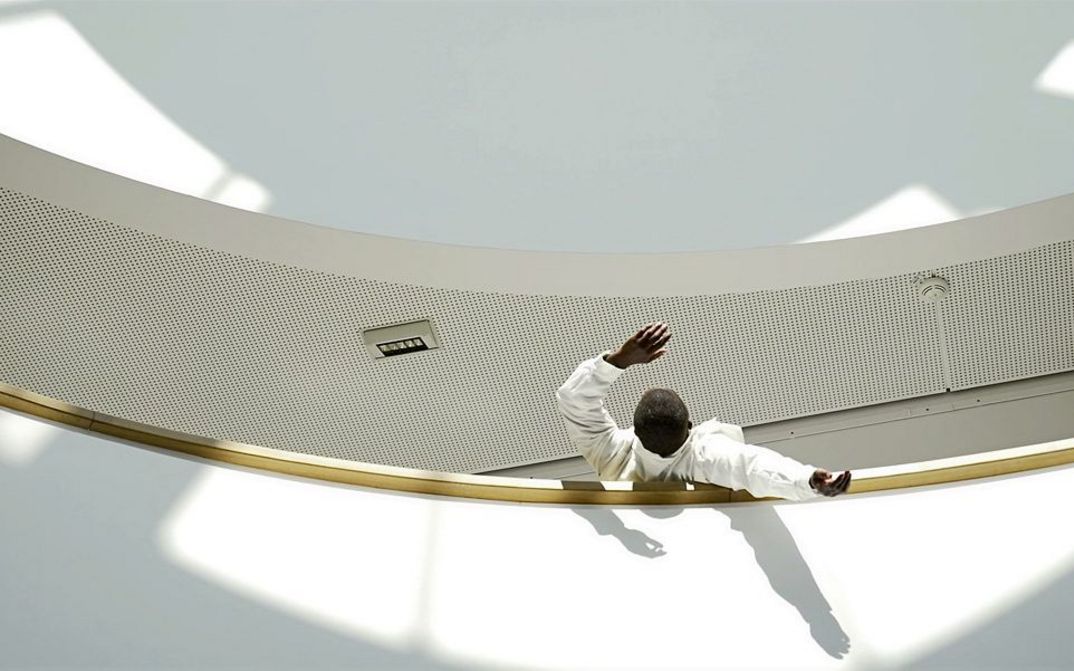Program 4

Tue 15.02.
11:00
Cinema
Arsenal 1
Short film program consisting of JAIL BIRD IN A PEACOCK CHAIR, IF REVOLUTION IS A SICKNESS, and SOL IN THE DARK
Total running time approx. 74 min.
Director
James Gregory Atkinson
Germany, USA / 2021
4 min.
/ Original version
Original language
English
James Gregory Atkinson’s performative short film centers the history of the iconic Peacock Chair to interrogate contemporary social contexts and historical concepts of identities. The film engages the chair’s origins in forced prison labor in the Philippines, its status as an internationally traded “exotic” commodity, its use in portrait photography, and its associations with Black radical activists such as Huey P. Newton—to explore ideas of Black masculinities and resistance.
Through its filmic choreography of body and architecture, this work interweaves a nonlinear, experimental commentary on the American prison-industrial complex and the concept of the panopticon, and reflects both individual and governmental states of emergency.
Director
Diane Severin Nguyen
USA, Poland / 2021
19 min.
/ Original version
Original language
Polish, Vietnamese, English
Set in Warsaw, the film loosely follows the character of an orphaned Vietnamese child who grows up to be absorbed into a dance group inspired by South Korean pop music. Widely popular within Polish youth subculture, K-pop is used by the artist as a vernacular material to trace a relationship between Eastern Europe and Asia with roots in Cold War allegiances. This dichotomy is further complicated by the significant Vietnamese diaspora currently living in Poland, composed of Northerners who migrated before the fall of the Iron Curtain, and Southerners who came in the aftermath of the Vietnam War. Nguyen traces how these layered inner conflicts are reckoned with inside the process of finding shared symbols and naming oneself from within another’s regime.
Assembling a crew of teenaged Polish dancers who perform original choreography set to music and lyrics co-written by the artist, she looks at both the exaltation and erasure of personal traumas at play in the process of representation, identity building, and the formation of a shared nation space. The melodramatic pull of the spectacle is disrupted by the voice-over, culled from various and often contradictory writings on revolution by Ulrike Meinhof, Hannah Arendt, Mao Zedong, and others.
Director
Mawena Yehouessi
France / 2021
51 min.
/ Original version with English subtitles
Original language
French, English
SOL IN THE DARK is a cinematographic and multimedia collage project by Mawena Yehouessi, whose ambition is to generate new contexts of co-creation as synonyms of alternative modes of coexistence. From script writing to filming, post-production and distribution, the film is an invitation to over fifty artists, researchers, students, and amateurs to retrace altogether—in a poetic and speculative way—the Myth of “Lascar.”
The term Lascar is said to come from Persian, meaning “army.” It was notably used during the 19th century to designate South East Asian native soldiers enrolled by the European colonial forces at sea. In the 1990s in France, Lascar has become a contemptuous qualifier, referring to 2nd and 3rd generation French BIPOC kids from the suburbs—from their daily struggles to their knowledge-making. As such, Lascar appears as both the epicene symbol and symptom of ghosted heredities as much as a fictitious role-model to youth standing on the edges of artistic, academic, media-related, and state-related institutional spaces. The film triggers fugitive modes of narration, representation, and co(n)generation in a post-internet world, and incites some of the viewers to reclaim its collage methodology and tell their own (Afrofuturist) stories—both in content and in form.